clutch TOYOTA CAMRY 2011 XV50 / 9.G Owners Manual
[x] Cancel search | Manufacturer: TOYOTA, Model Year: 2011, Model line: CAMRY, Model: TOYOTA CAMRY 2011 XV50 / 9.GPages: 554, PDF Size: 9.69 MB
Page 122 of 554
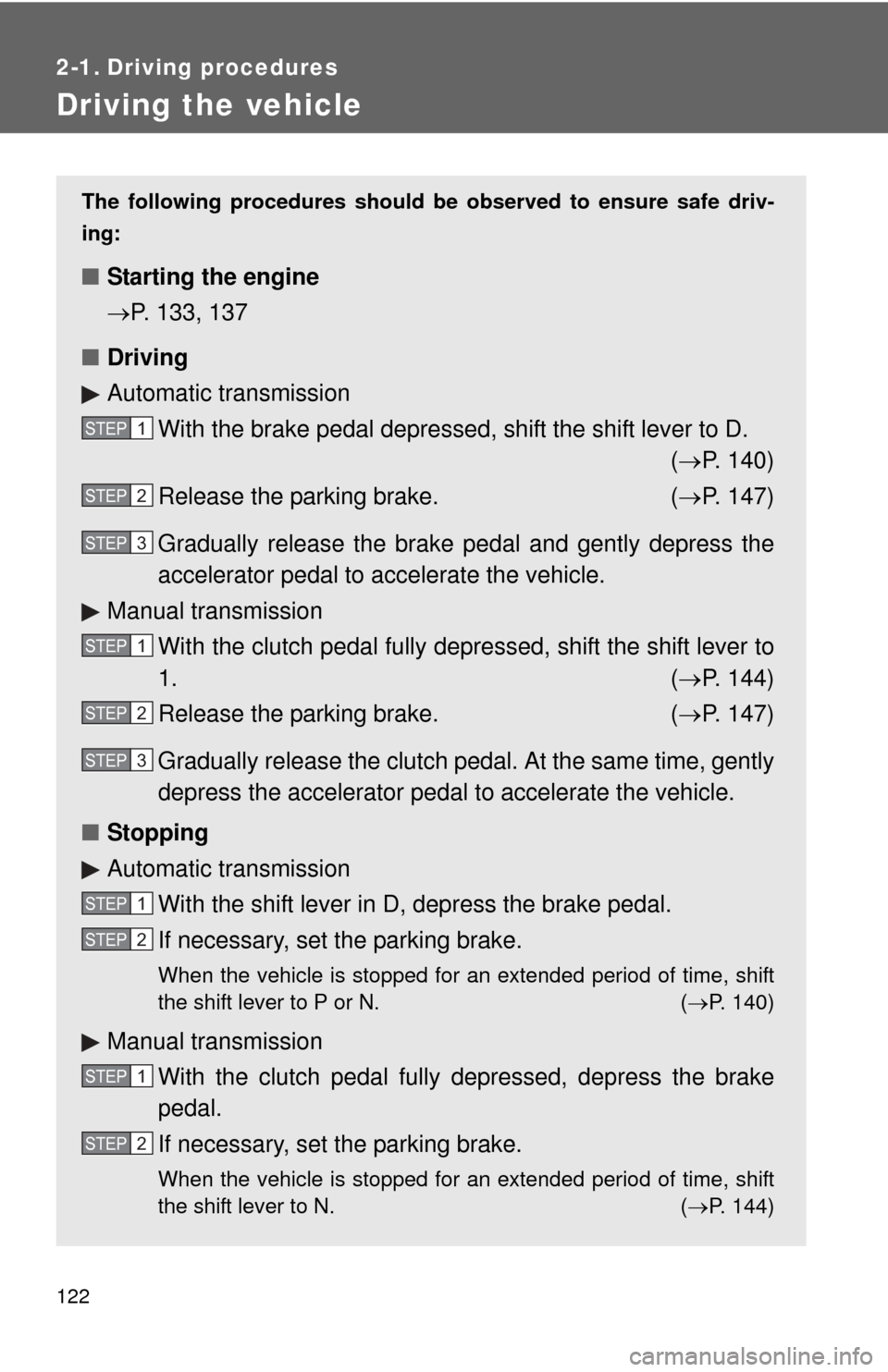
122
2-1. Driving procedures
Driving the vehicle
The following procedures should be observed to ensure safe driv-
ing:
â– Starting the engine
ď‚®P. 133, 137
â– Driving
Automatic transmission
With the brake pedal depressed, shift the shift lever to D. (ď‚® P. 140)
Release the parking brake. (ď‚® P. 147)
Gradually release the brake pedal and gently depress the
accelerator pedal to accelerate the vehicle.
Manual transmission With the clutch pedal fully depressed, shift the shift lever to
1. (ď‚® P. 144)
Release the parking brake. (ď‚® P. 147)
Gradually release the clutch pedal. At the same time, gently
depress the accelerator pedal to accelerate the vehicle.
â– Stopping
Automatic transmission
With the shift lever in D, depress the brake pedal.
If necessary, set the parking brake.
When the vehicle is stopped for an extended period of time, shift
the shift lever to P or N. ( ď‚®P. 140)
Manual transmission
With the clutch pedal fully depressed, depress the brake
pedal.
If necessary, set the parking brake.
When the vehicle is stopped for an extended period of time, shift
the shift lever to N. ( ď‚®P. 144)
STEP1
STEP2
STEP3
STEP1
STEP2
STEP3
STEP1
STEP2
STEP1
STEP2
Page 123 of 554
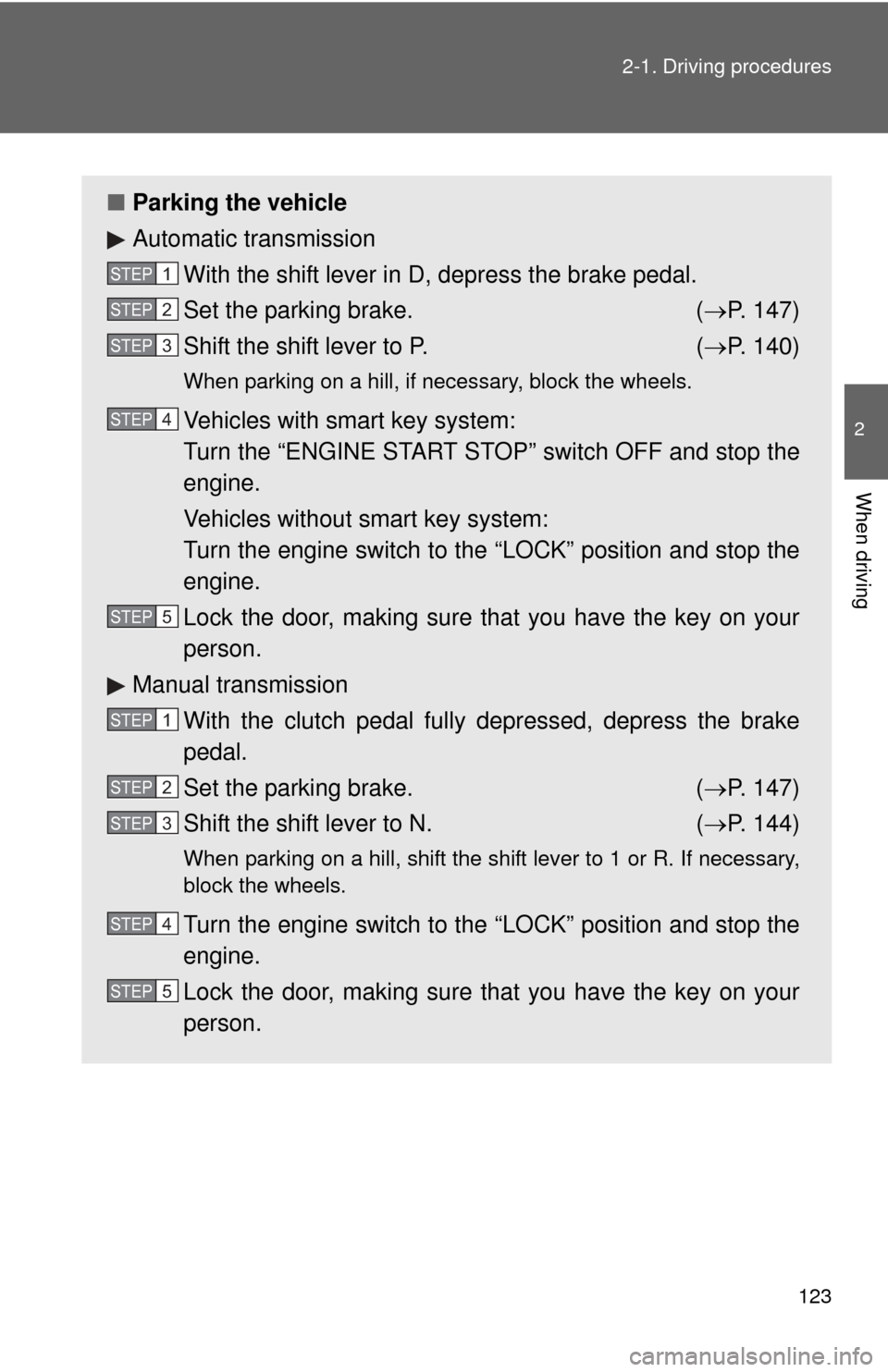
123
2-1. Driving procedures
2
When driving
â–
Parking the vehicle
Automatic transmission
With the shift lever in D, depress the brake pedal.
Set the parking brake. ( ď‚®P. 147)
Shift the shift lever to P. ( ď‚®P. 140)
When parking on a hill, if necessary, block the wheels.
Vehicles with smart key system:
Turn the “ENGINE START STOP” switch OFF and stop the
engine.
Vehicles without smart key system:
Turn the engine switch to the “LOCK” position and stop the
engine.
Lock the door, making sure that you have the key on your
person.
Manual transmission
With the clutch pedal fully depressed, depress the brake
pedal.
Set the parking brake. ( ď‚®P. 147)
Shift the shift lever to N. ( ď‚®P. 144)
When parking on a hill, shift the shift lever to 1 or R. If necessary,
block the wheels.
Turn the engine switch to the “LOCK” position and stop the
engine.
Lock the door, making sure that you have the key on your
person.
STEP1
STEP2
STEP3
STEP4
STEP5
STEP1
STEP2
STEP3
STEP4
STEP5
Page 124 of 554

124 2-1. Driving procedures
Starting on a steep uphillAutomatic transmission Firmly set the parking brake and shift the shift lever to D.
Gently depress the accelerator pedal.
Release the parking brake.
Manual transmission
With the parking brake firmly set and the clutch pedal fully
depressed, shift the shift lever to 1.
Lightly depress the accelerator pedal at the same time as
gradually releasing the clutch pedal.
Release the parking brake.
â– Driving in the rain
â—ŹDrive carefully when it is raining, because visibility will be reduced, the
windows may become fogged-up, and the road will be slippery.
â—Ź Drive carefully when it starts to rain, because the road surface will be
especially slippery.
â—Ź Refrain from high speeds when driving on an expressway in the rain,
because there may be a layer of water between the tires and the road
surface, preventing the steering and brakes from operating properly.
â– Breaking in your new Toyota
To extend the life of the vehicle, the following precautions are recommended
to observe:
â—ŹFor the first 186 miles (300 km):
Avoid sudden stops.
â—Ź For the first 994 miles (1600 km):
• Do not drive at extremely high speeds.
• Avoid sudden acceleration.
• Do not drive continuously in the low gears.
• Do not drive at a constant speed for extended periods.
STEP1
STEP2
STEP3
STEP1
STEP2
STEP3
Page 131 of 554

131
2-1. Driving procedures
2
When driving
NOTICE
â–
When driving the vehicle
â—ŹDo not depress the accelerator and brake pedals at the same time during
driving, as this may restrain the engine output.
Manual transmission
â—Ź Do not shift gears unless the clutch pedal is fully depressed. After shifting,
do not release the clutch abruptly. Doing so may damage the clutch, trans-
mission and gears.
â—Ź Do not rest your foot on the clutch pedal while driving.
Doing so may cause clutch trouble.
â—Ź Do not use any gears other than the first gear when starting off and mov-
ing forward.
Doing so may damage the clutch.
â—Ź Do not use the clutch to hold the vehicle when stopping on an uphill grade.
Doing so may damage the clutch.
â—Ź Do not shift into reverse when the vehicle is still moving. Doing so may
damage the clutch, transmission and gears.
Automatic transmission
Do not use the accelerator pedal or depress the accelerator and brake ped-
als together to hold the vehicle on a hill.
â– When parking the vehicle
Vehicles with an automatic transmission: Always put the shift lever in P. Fail-
ure to do so may cause the vehicle to move or the vehicle may accelerate
suddenly if the accelerator pedal is accidentally depressed.
â– Avoiding damage to vehicle parts
â—ŹDo not turn the steering wheel fully in either direction and hold it there for a
long time.
Doing so may damage the power steering motor.
â—Ź When driving over bumps in the road, drive as slowly as possible to avoid
damaging the wheels, underside of the vehicle, etc.
Page 137 of 554
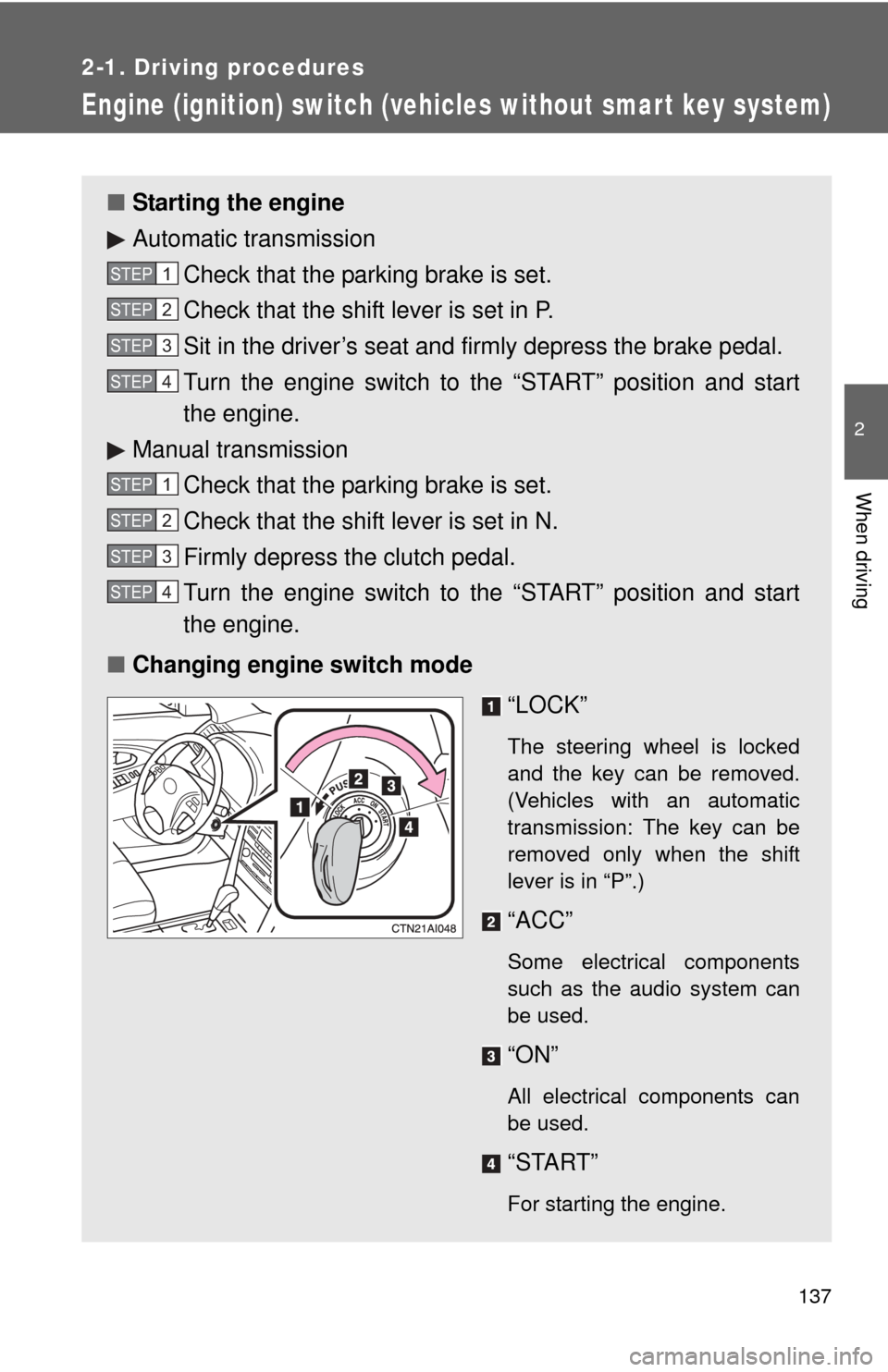
137
2-1. Driving procedures
2
When driving
Engine (ignition) switch (vehicles without smart key system)
â– Starting the engine
Automatic transmission
Check that the parking brake is set.
Check that the shift lever is set in P.
Sit in the driver’s seat and firmly depress the brake pedal.
Turn the engine switch to the “START” position and start
the engine.
Manual transmission Check that the parking brake is set.
Check that the shift lever is set in N.
Firmly depress the clutch pedal.
Turn the engine switch to the “START” position and start
the engine.
â– Changing engine switch mode
“LOCK”
The steering wheel is locked
and the key can be removed.
(Vehicles with an automatic
transmission: The key can be
removed only when the shift
lever is in “P”.)
“ACC”
Some electrical components
such as the audio system can
be used.
“ON”
All electrical components can
be used.
“START”
For starting the engine.
STEP1
STEP2
STEP3
STEP4
STEP1
STEP2
STEP3
STEP4
Page 144 of 554
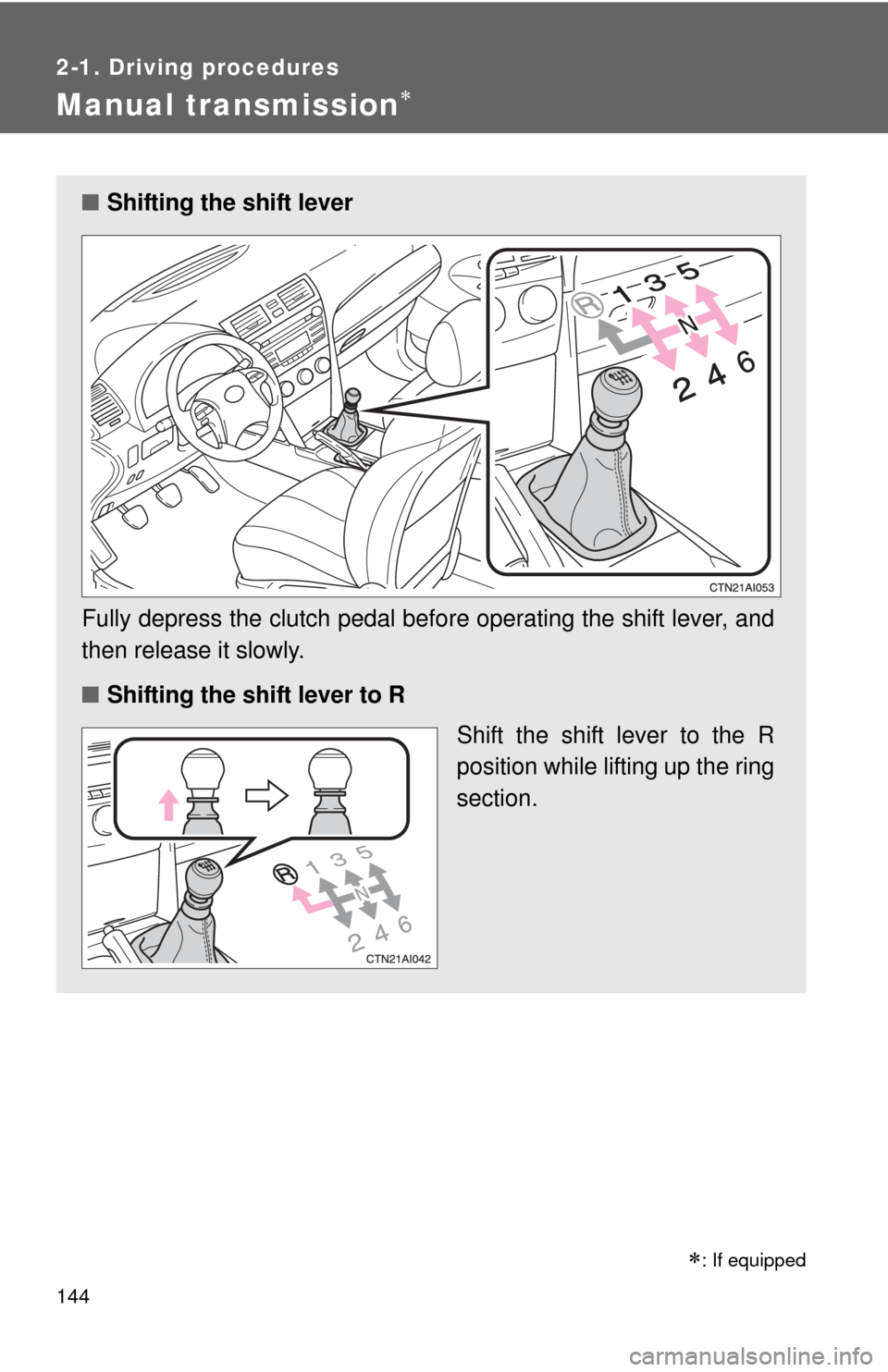
144
2-1. Driving procedures
Manual transmission
â– Shifting the shift lever
Fully depress the clutch pedal before operating the shift lever, and
then release it slowly.
â– Shifting the shift lever to R
Shift the shift lever to the R
position while lifting up the ring
section.
�
: If equipped
Page 145 of 554
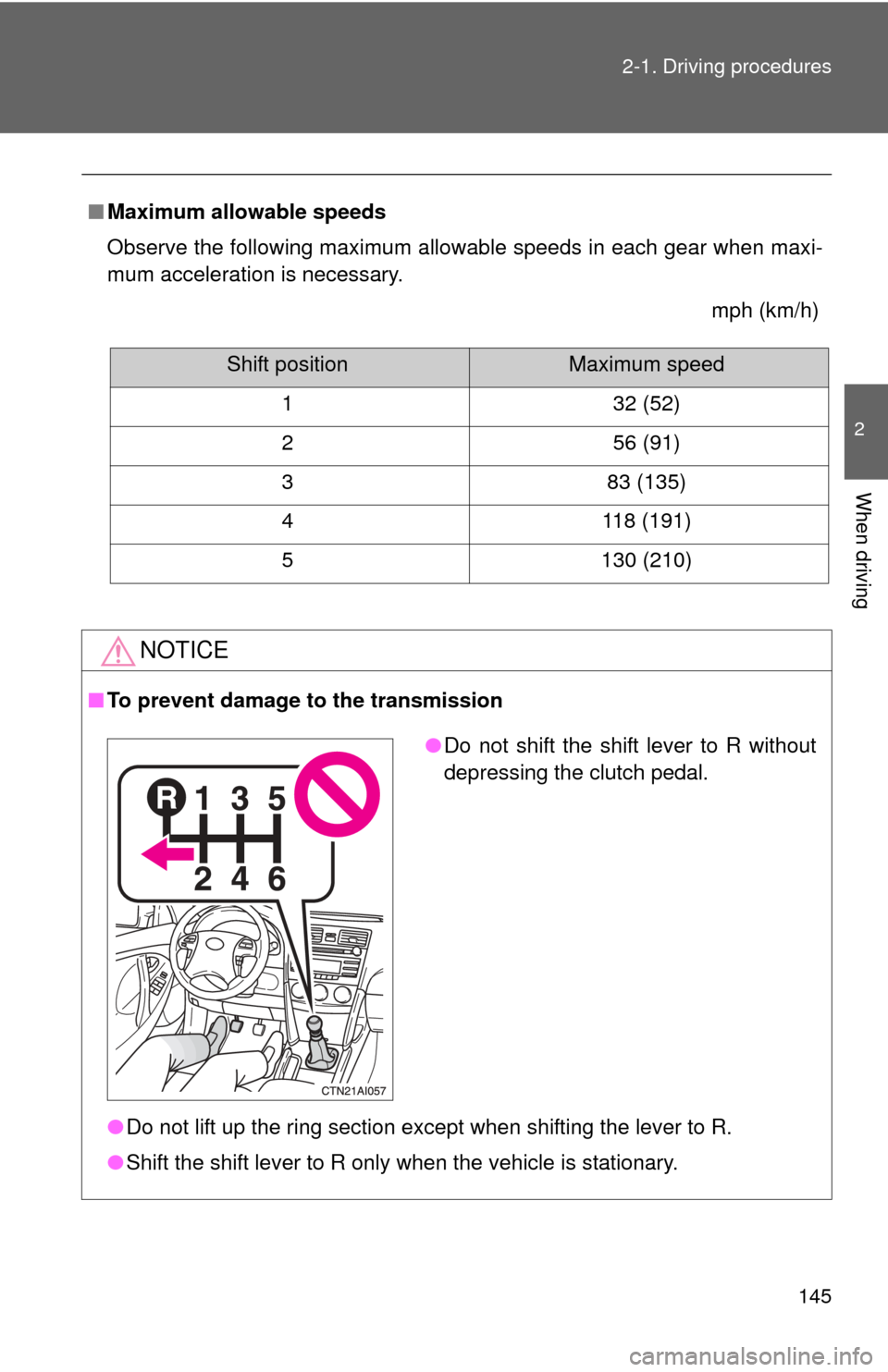
145
2-1. Driving procedures
2
When driving
â–
Maximum allowable speeds
Observe the following maximum allowable speeds in each gear when maxi-
mum acceleration is necessary.
mph (km/h)
NOTICE
â– To prevent damage to the transmission
â—ŹDo not lift up the ring section except when shifting the lever to R.
â—Ź Shift the shift lever to R only when the vehicle is stationary.
Shift positionMaximum speed
1 32 (52)
2 56 (91)
3 83 (135)
4 118 (191)
5 130 (210)
â—Ź Do not shift the shift lever to R without
depressing the clutch pedal.
Page 172 of 554
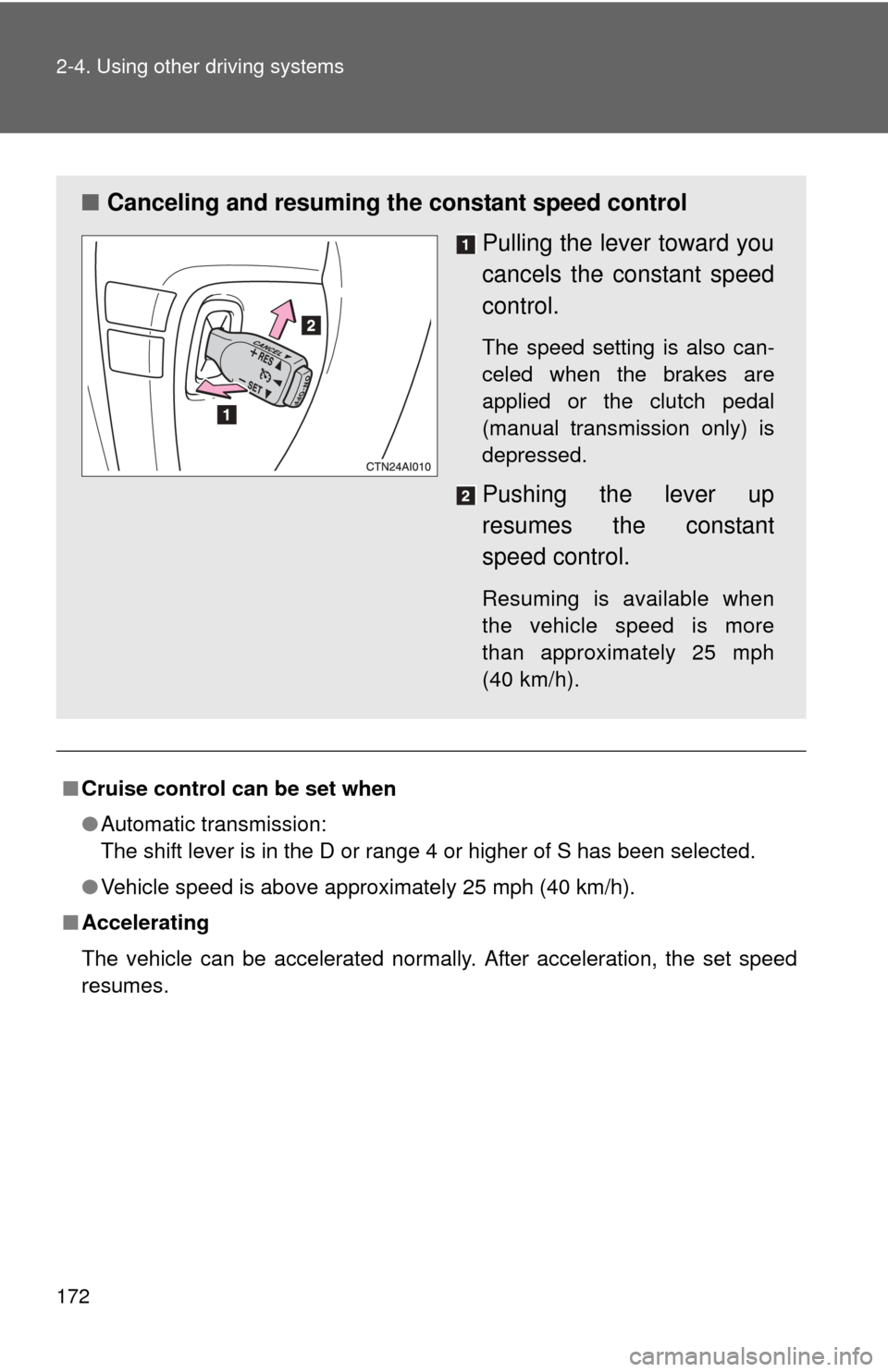
172 2-4. Using other driving systems
â– Cruise control can be set when
â—ŹAutomatic transmission:
The shift lever is in the D or range 4 or higher of S has been selected.
â—Ź Vehicle speed is above approximately 25 mph (40 km/h).
â– Accelerating
The vehicle can be accelerated normally. After acceleration, the set speed
resumes.
â– Canceling and resuming the constant speed control
Pulling the lever toward you
cancels the constant speed
control.
The speed setting is also can-
celed when the brakes are
applied or the clutch pedal
(manual transmission only) is
depressed.
Pushing the lever up
resumes the constant
speed control.
Resuming is available when
the vehicle speed is more
than approximately 25 mph
(40 km/h).
Page 181 of 554

181
2-5. Driving information
2
When driving
CAUTION
â– Storage precautions
Observe the following precautions.
Failing to do so may result in death or serious injury.
â—ŹVehicles with fold-down type rear
seat: To prevent cargo and luggage
from sliding forward during braking, do not stack anything in the
enlarged trunk. Keep cargo and luggage low, as close to the floor as
possible.
â—ŹVehicles with fold-down type rear seat: Never allow anyone to ride in
the enlarged trunk. It is not design ed for passengers. They should ride
in their seats with their seat belts properly fastened. Otherwise, they
are much more likely to suffer death or serious bodily injury, in the
event of sudden braking, sudden swerving or an accident.
â—ŹDo not place cargo or luggage in or on the following locations as the
item may get under the clutch, brake or accelerator pedal and prevent
the pedals from being depressed properly, block the driver’s vision, or
hit the driver or passengers, causing an accident.
• Driver’s feet
• Front passenger or rear seats (when stacking items)
• Package tray
• Instrument panel
• Dashboard
â—ŹSecure all items in the occupant compartment, as they may shift and
injure someone during sudden braking, sudden swerving or an acci-
dent.
â– Capacity and distribution
â—ŹDo not exceed the maximum axle weight rating or the total vehicle
weight rating.
â—ŹEven if the total load of occupant's weight and the cargo load is less
than the total load capacity, do not apply the load unevenly.
Improper loading may cause deterioration of steering or braking con-
trol which may cause death or serious injury.
Page 193 of 554

193
2-5. Driving information
2
When driving
â—Ź
In order to maintain efficient engine braking and electrical charging
performance, do not use overdrive (automatic transmission) or the
5th gear (manual transmission).
â—Ź Due to the added load of the trailer, your vehicle's engine may
overheat on hot days (at temperatures over 85°F [30°C]) when
driving up a long or steep grade. If the engine coolant temperature
gauge indicates overheating, immedi ately turn off the air condition-
ing (if in use), pull your vehicle off the road and stop in a safe spot.
( ď‚® P. 479)
â—Ź Always place wheel blocks under both the vehicle and the trailer
wheels when parking. Apply the parking brake firmly, and put the
transmission in P (automatic transmission) or in first or R (manual
transmission). Avoid parking on a slope, but if unavoidable, do so
only after performing the following:
Apply the brakes and keep them applied.
Have someone place wheel blocks under both the vehicle and
trailer wheels.
When the wheel blocks are in pl ace, release the brakes slowly
until the blocks absorb the load.
Apply the parking brake firmly.
Shift into first or R (manual transmission) or P (automatic
transmission) and turn off the engine.
â—Ź When restarting after parking on a slope:
With the transmission in the P position (automatic transmis-
sion) or the clutch pedal (m anual transmission) depressed,
start the engine. On vehicles with an automatic transmission,
be sure to keep the brake pedal pressed.
Shift into a forward gear. If reversing, shift into the R position.
Release the parking brake (also brake pedal on vehicles with
automatic transmission), and sl owly pull or back away from
the wheel blocks. Stop and apply the brakes.
Have someone retrieve the blocks.
STEP1
STEP2
STEP3
STEP4
STEP5
STEP1
STEP2
STEP3
STEP4